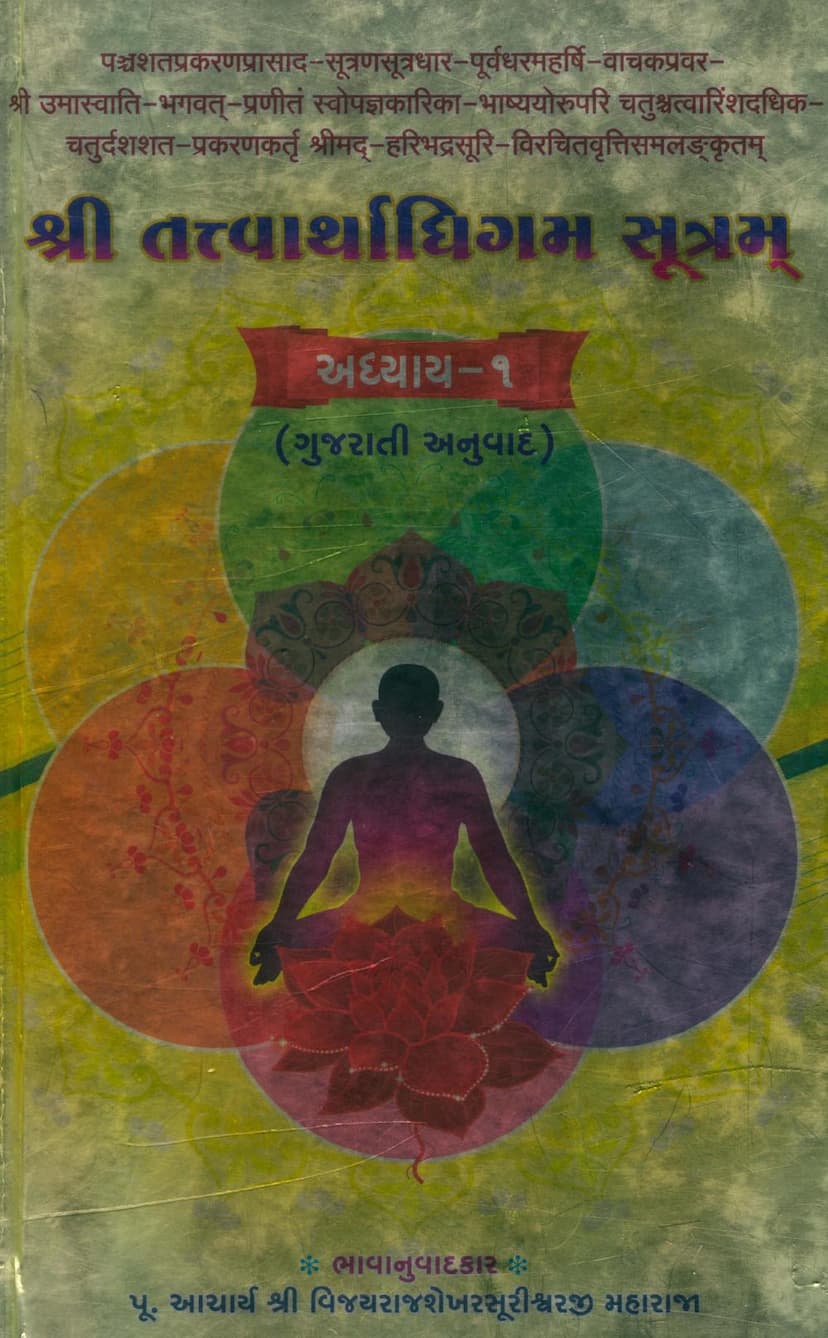Tattvarthadhigam Sutram Part 01
Added to library: September 2, 2025
Loading image...

Summary
This document is the first part (Chapter 1) of the Tattvarthadhigam Sutram, a foundational text in Jainism. It includes a Gujarati translation and commentary, along with introductory material and a detailed table of contents.
Key aspects covered in this part:
- Title: Tattvarthadhigam Sutram, Part 01
- Author: Pt. Shri Umaswati Bhagwat (also known as Pt. Shri Umaswati Maharshi)
- Commentary: Vritti Samalankrutam by Pt. Shrimad Haribhadrasuri
- Publisher: Shri Arihant Aradhak Trust
- Content: The document begins with introductory pages, listing other published works by the trust and acknowledging various revered Acharyas. It then delves into the first chapter of the Tattvarthadhigam Sutram, presenting the sutras, their Gujarati translation, and detailed commentary.
- Introductory Material: The initial pages highlight the extensive literary contributions of various Jain Acharyas, including those involved in the translation and commentary of this particular text. It also includes details about the publication, such as the edition, print run, price, and contact information.
- Tattvarthadhigam Sutram - Chapter 1:
- Introduction to the Text: The text is identified as a primary source for understanding Dravyanuyoga (the study of substances) in Jainism, which is considered one of the four main branches of Jain philosophy. It emphasizes that understanding this scripture leads to the development and strengthening of Samyagdarshan (right faith).
- Authorship and Commentary: The authorship of the original Sutras is attributed to Pt. Shri Umaswati Bhagwat, who also authored the Bhashya (commentary). The Digambara tradition disputes the Bhashya's authorship, but the document suggests arguments exist to prove it is Umaswati's. The Vritti (commentary) on the Bhashya is by Pt. Shrimad Haribhadrasuri, who is noted for his extensive commentary work.
- Significance: The Tattvarthadhigam Sutram is described as a concise yet comprehensive work, containing the essence of the entire Jain philosophy. It is likened to fitting an ocean into a pot.
- The Sutras (Chapter 1): The first chapter, as presented here, begins with the fundamental definition of the path to liberation:
- Sutra 1.1: Right faith, right knowledge, and right conduct constitute the path to liberation.
- Sutra 1.2: Right faith is the conviction in truths (Tattvas).
- Sutra 1.3: Right faith arises from innate disposition or acquired knowledge.
- Sutra 1.4: The Tattvas (truths) are soul, non-soul, influx, bondage, stoppage, dissociation, and liberation.
- Sutra 1.5: These are named by name, designated by designation, considered by substance, and understood by mode.
- Sutra 1.6: Knowledge is obtained through valid means of knowledge (Pramana) and standpoints (Naya).
- Sutras 1.7-1.8: These outline the methods for understanding Tattvas, involving enumeration, classification, etc.
- Sutras 1.9-1.31: These detail the different types of knowledge (Mati, Sruta, Avadhi, Manahparyaya, Kevala) and their characteristics, including direct (Pratyaksha) and indirect (Paroksha) knowledge.
- Sutras 1.32-1.35: These discuss the concepts of false knowledge (Viparyaya) and the different standpoints (Naya - Naigama, Sangraha, Vyavahara, Riju-sutra, Shabda).
- Commentary Details: The commentary explains each sutra, providing philosophical insights, etymological derivations of terms, and discussions on various interpretations. It also includes biographical details about the authors and historical context of the commentaries.
- Table of Contents (Vishayanukram): A comprehensive index is provided, detailing the specific topics and sutras covered in the first chapter, indicating the depth of the commentary.
- Dedication and Gratitude: The publication expresses gratitude to the supporting organizations and individuals, particularly highlighting the contributions of Acharya Rajshekharsurishwarji Maharaj, who is responsible for the Gujarati translation and commentary.
In essence, this document is a scholarly presentation of the first chapter of the Tattvarthadhigam Sutram, aiming to make its profound philosophical teachings accessible through a detailed Gujarati translation and commentary. It underscores the text's importance in the Jain tradition for understanding core principles of reality and the path to liberation.